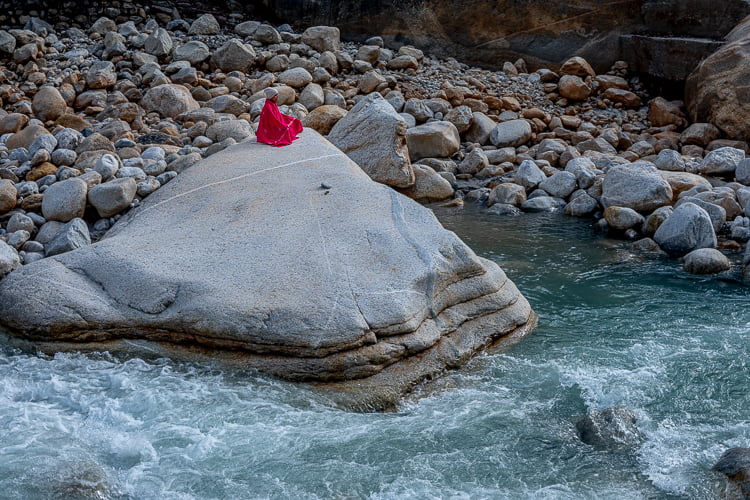Jambudvipa is the name of the continent of Earth according to the concept of Hinduism…. is divided into four vast regions shaped like four petals of lotus with Mount Meru being located at the center like the pericarp of the flower…..Bharata lies on the south… The river Ganga or Akashganga encloses the city of Brahmapuri. River Ganga is said to emerge from the foot of Lord Vishnu and … falls ‘through the skies’…..
The mountain jeep picked me up from the Five Elements hotel, Uttarkashi, at 7.30am.
I had long held a desire to journey to Gangotri, a small town of pilgrimage high in the Himalaya mountain range and one of the Char Dhams, the four sources of the river Ganges, where statues dedicated to Ma Ganga, the Goddess, are revered in temples. My initial plan was to visit Gangotri festival which celebrated the return of the Ma Ganga statue to its mountain abode from its wintering temple in the lower village of Mukti. I had also ambitiously envisioned walking the trail from Gangotri to the ice cave at Gaumohk, from where the river issues, at the foot of Gangotri glacier. Here Sadhus and other holy men celebrate the location by bathing in the freezing waters.
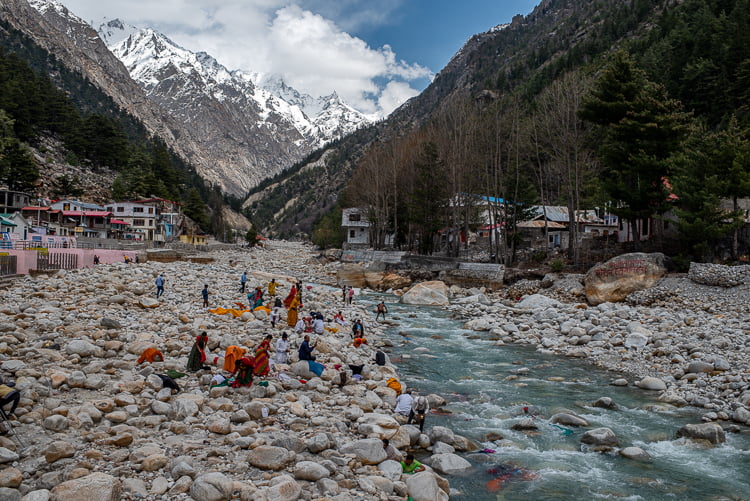
However the April snow had made both plans impossible. The procession up the mountain had occurred in continuing snowstorms and there was no easy way to join the festive gathering, and the 19 kilometre trail to Gomukh and the ice cave remained closed under snow.
The mythical story describing the origin of the river Ganges is both beautiful and fascinating :
The story begins with a sage, Kapila, whose intense meditation has been disturbed by the sixty thousand sons of King Sagara. Livid at being disturbed, Kapila sears them with his angry gaze, reduces them to ashes, and dispatches them to the netherworld. Only the waters of the Ganges, then in heaven, can bring the dead sons their salvation. A descendant of these sons, King Bhagiratha, anxious to restore his ancestors, undertakes rigorous penance and is eventually granted the prize of Ganges’s descent from heaven. However, since her turbulent force would also shatter the earth, Bhagiratha persuades Shiva in his abode on Mount Kailash to receive the Ganges in the coils of his tangled hair and break her fall. The Ganges descends, is tamed in Shiva’s locks, and arrives in the Himalayas. She is then led by the waiting Bhagiratha down into the plains at Haridwar, across the plains first to the confluence with the Yamuna at Prayag and then to Varanasi, and eventually to Ganges Sagar (Ganges delta), where she meets the ocean, sinks to the netherworld, and saves the sons of Sagara. In honour of Bhagirath’s pivotal role in the avatarana, the source stream of the Ganges in the Himalayas is named Bhagirathi.
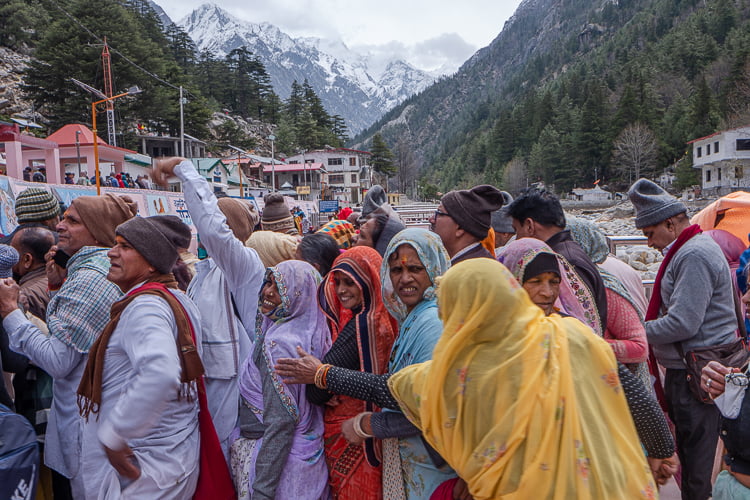
The manager at the Five Elements hotel had organised both the jeep and accomodation in Gangotri. I kept my room open at the hotel and left most of my belongings there, taking with me only minimal possessions. My new objective, as the jeep pulled away, was to spend 3 nights in Gangotri and to photograph the landscape, shrines and pilgrims there as best as I could.
The jeep provided daily supplies to shops, cafes and hotels along the 100 kilometre mountain road. It initially stocked up with food, milk and other supplies in the bustling markets of Uttarkashi, and its first stop was just several miles outside of the town, at a large army camp. The troublesome border with China was just beyond Gangotri and there were significant numbers of military camps along the roadside. The supplies provided to the first camp surprised me: a large case of whiskey. The road wound higher and higher through a magnificent landscape of ravines, river torrents, majestic peaks, orchards and vast unfolding terrain where small isolated villages hugged tracts of exposed heathland which seemed to melt into the very clouds on the horizon. Colourful shrines dedicated to a plethora of Hindu deities precipitously nestled amongst these folds; one of the first we saw was the ashram of Pilot Baba, formerly Wing Commander Kapil Singh of the Indian air force, now a sanyassi who had by legend landed his unresponding plane with the distant spiritual assistance of his guru Hari Baba. Following this experience Pilot Baba elected to pursue a spiritual pathway and became an iconic holy man with a gift for healing. He has an ashram in Gangotri, as well as other cities in India.
Eventually a line of parked coaches came into view snaking down the road out of Gangotri; these were the transport for the hundreds, if not thousands, of Hindus who travel to the remotest of pilgrimage sites across India. Gangotri had barely been re-opened for a week following its winter closure and pilgrims had arrived in their multitudes.
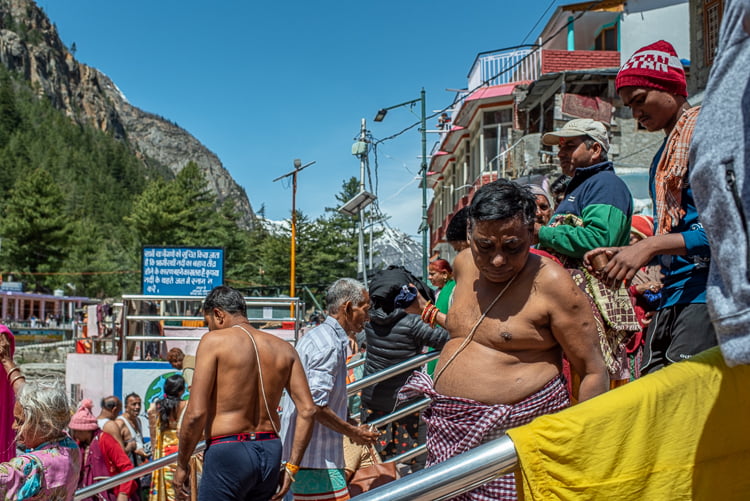
For three days the sun shone weakly at an altitude of over 10,000 feet, and clouds scudded across the sky between the snow lined peaks which surround Gangotri and march ever higher towards the Gangotri glacier further north. Sometimes the skies clouded darkly over and cold rain fell, at other times the clouds gathered like armies of lighter shades and snow fell silently over the collection of houses, ashrams, hostels and hotels lining the river Bhagiratha. The river tumultuously descended around and over strangely shaped and coloured rocks, eventually meeting downstream with the river Alaknanda at Devprayag, the two river’s two distinct colours co-alescing and metamorphosing finally into the river Ganges.
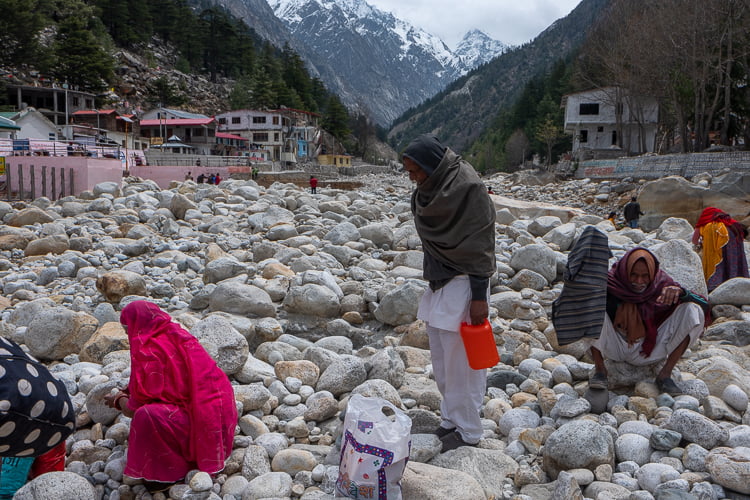
The gleaming white temple of Ma Ganga sat beyond the rows of trinket sellers and restaurants and hotels along the only main street of Gangotri. The restaurants were crowded and offered dishes from all the disparate regions of India, and token meals for pilgrims from the West, the waiters often crudely multi-lingual. Glimpses of the Bhagiratha could be seen through the right hand buildings perhaps a hundred feet below, tunbling along its path. Walking towards the temple meant struggling through crowds of people gathered to store their footware in a shoe-bank and to buy pujas and ornaments to offer later at both the temple and the line of ghats where pilgrims gathered and immersed themselves in the freezing waters. Colour was everywhere; a blur of saris, turbans and flowers. The sounds of ringing bells accompanied the tumult. Discarded or lost saris trapped between rocks shimmered like long colourful eels in the glistening waters. Devotees meditated on the largest rocks riverside, enjoying the warmth of the pale sun.
The queue for entry into the temple stretched considerably back into the village, winding its way snake like, pilgrims waiting patiently. I managed to visit the Temple on 2 occasions, and saw the diminutive sacred statue of Ganga in her summer residence. A no photography rule was strictly enforced.
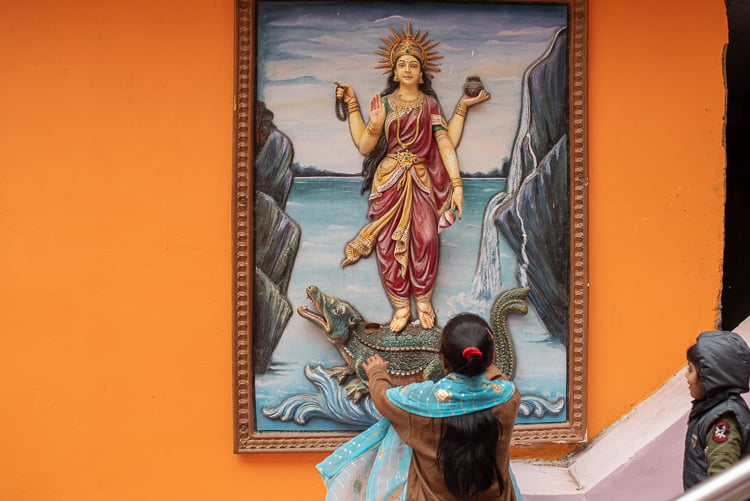
Just outside of the Temple area, down a series of steep steps where a relief of Ma Ganga riding her Makara ( a creature with the head of a crocodile and the tail of a dolphin ) featured in the wall, the ghats stretched along the riverside. Here pilgrims of all ages and from all over India clambered down the steps, clasping silver metal bars for security and waded tentatively and then bravely into the fast flowing water, the act of immersion providing a divine guarantee of salvation, redemption and freedom from the chore of further lives for the multitudes.

Sanyassis, the enigmatic holy men of India who renounce all physical possessions and eschew most emotional ties, wandered through the crowds, wearing orange robes and carrying often a staff, or trident, and a kumbh, or pot, in which they kept water for drinking or food for eating. I struck up a conversation with one of them, Swami Deepak Giri, who became a Facebook friend and whose portrait heads this blog post. His life is one of constant pilgrimage across India, relying on the benevolence of a society which factors in the encouragement of spiritual expression across a country which some see exclusively as a sacred landscape.
A collection of large friezes provide representation of the deities whose sacred forms delineate this landscape. A huge tableau of Shiva and his his family, represented in the blue firmament, looked down over the Temple.
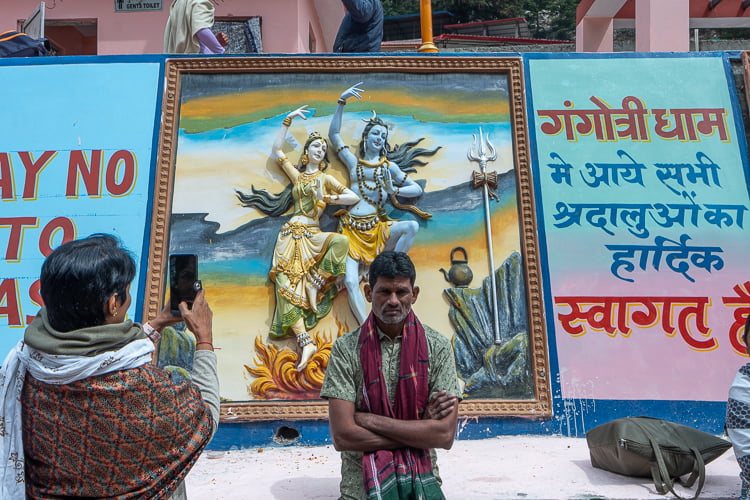
The spiritual significance of the Ganga cannot be overstated. The river is considered the holiest of all rivers by Hindus. Ma Ganga is personified as a goddess and worshipped as Goddess Ganga and is seen as a mother to humanity. Pilgrims immerse the ashes of their kin in the river Ganga, which is considered by them to bring the souls (purified spirits) closer to moksha, the liberation from the cycle of life and death. The ghats of Manikarnika in Varanasi are considered the most revered of all cremation sites along the Ganges’ banks. Festivals like Ganga Dussehra and Ganga Jayanti are celebrated in her honour at several sacred places, which lie along the banks of the Ganges, including Gangotri, Haridwar, Prayagraj, Varanasi and Kali Ghat in Kolkata. Alongside Gautama Buddha, Ganga is worshipped during the Loy Krathong festival in Thailand.
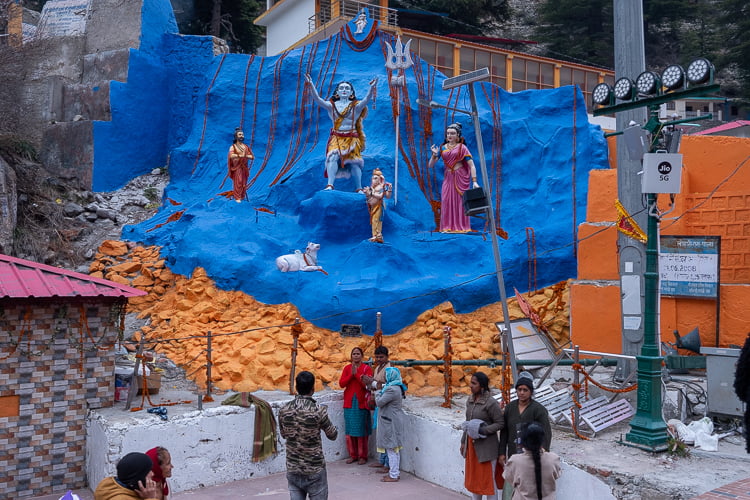
Beyond the temple and the ghats a scattering of buildings beside the river petered out after just a few meters, and the river vanished around a bend enclosed by a series of growing stony hillsides. On the higher horizon, snow clad peaks receded further. Somewhere in that landscape a rocky path wound a further 19 kilometres tracing the riverside, threading its way through huge boulders and plateaus of scree and landslides, until it reached the sacred ice cave of Gaumohk, literally transated as the cow’s mouth. From here the frothing bubbling young river Bhagiratha , an effigy of a living goddess, issued forth and hurried divinely down the multi-coloured descending rocky incline, through Gangotri on course to meet Her glorious destiny at the confluence of DevPrayeg.
